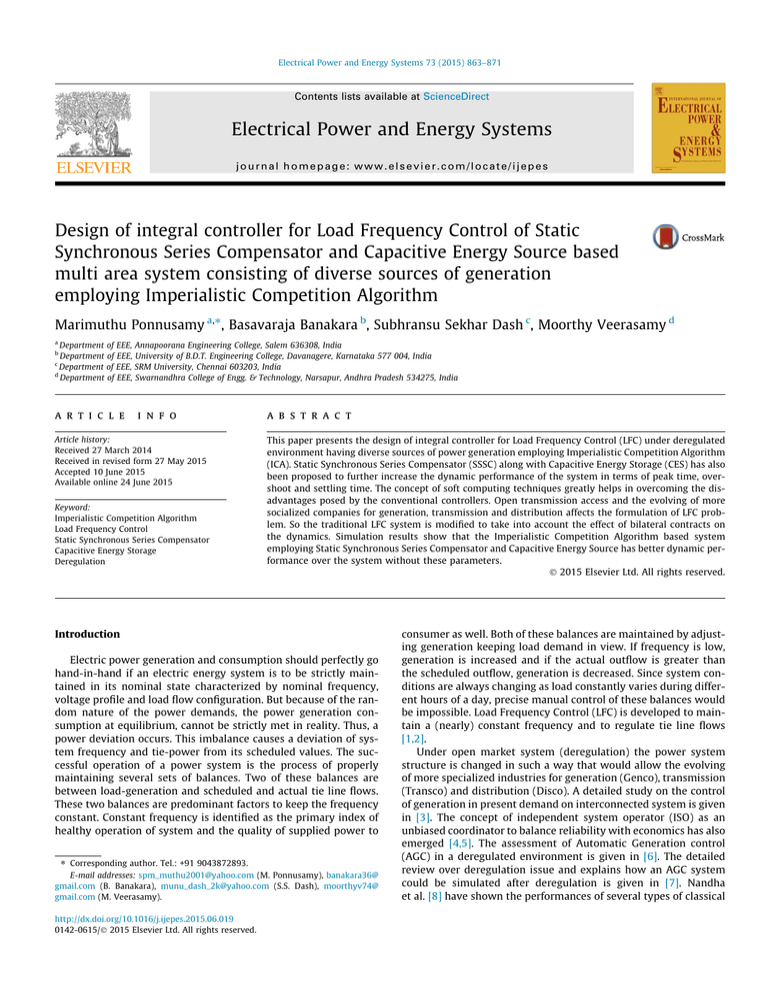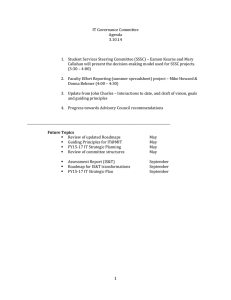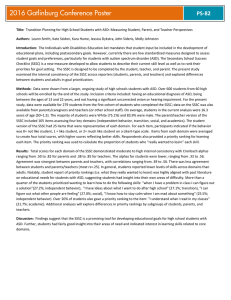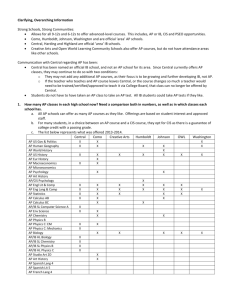
Electrical Power and Energy Systems 73 (2015) 863–871
Contents lists available at ScienceDirect
Electrical Power and Energy Systems
journal homepage: www.elsevier.com/locate/ijepes
Design of integral controller for Load Frequency Control of Static
Synchronous Series Compensator and Capacitive Energy Source based
multi area system consisting of diverse sources of generation
employing Imperialistic Competition Algorithm
Marimuthu Ponnusamy a,⇑, Basavaraja Banakara b, Subhransu Sekhar Dash c, Moorthy Veerasamy d
a
Department of EEE, Annapoorana Engineering College, Salem 636308, India
Department of EEE, University of B.D.T. Engineering College, Davanagere, Karnataka 577 004, India
c
Department of EEE, SRM University, Chennai 603203, India
d
Department of EEE, Swarnandhra College of Engg. & Technology, Narsapur, Andhra Pradesh 534275, India
b
a r t i c l e
i n f o
Article history:
Received 27 March 2014
Received in revised form 27 May 2015
Accepted 10 June 2015
Available online 24 June 2015
Keyword:
Imperialistic Competition Algorithm
Load Frequency Control
Static Synchronous Series Compensator
Capacitive Energy Storage
Deregulation
a b s t r a c t
This paper presents the design of integral controller for Load Frequency Control (LFC) under deregulated
environment having diverse sources of power generation employing Imperialistic Competition Algorithm
(ICA). Static Synchronous Series Compensator (SSSC) along with Capacitive Energy Storage (CES) has also
been proposed to further increase the dynamic performance of the system in terms of peak time, overshoot and settling time. The concept of soft computing techniques greatly helps in overcoming the disadvantages posed by the conventional controllers. Open transmission access and the evolving of more
socialized companies for generation, transmission and distribution affects the formulation of LFC problem. So the traditional LFC system is modified to take into account the effect of bilateral contracts on
the dynamics. Simulation results show that the Imperialistic Competition Algorithm based system
employing Static Synchronous Series Compensator and Capacitive Energy Source has better dynamic performance over the system without these parameters.
Ó 2015 Elsevier Ltd. All rights reserved.
Introduction
Electric power generation and consumption should perfectly go
hand-in-hand if an electric energy system is to be strictly maintained in its nominal state characterized by nominal frequency,
voltage profile and load flow configuration. But because of the random nature of the power demands, the power generation consumption at equilibrium, cannot be strictly met in reality. Thus, a
power deviation occurs. This imbalance causes a deviation of system frequency and tie-power from its scheduled values. The successful operation of a power system is the process of properly
maintaining several sets of balances. Two of these balances are
between load-generation and scheduled and actual tie line flows.
These two balances are predominant factors to keep the frequency
constant. Constant frequency is identified as the primary index of
healthy operation of system and the quality of supplied power to
⇑ Corresponding author. Tel.: +91 9043872893.
E-mail addresses: spm_muthu2001@yahoo.com (M. Ponnusamy), banakara36@
gmail.com (B. Banakara), munu_dash_2k@yahoo.com (S.S. Dash), moorthyv74@
gmail.com (M. Veerasamy).
http://dx.doi.org/10.1016/j.ijepes.2015.06.019
0142-0615/Ó 2015 Elsevier Ltd. All rights reserved.
consumer as well. Both of these balances are maintained by adjusting generation keeping load demand in view. If frequency is low,
generation is increased and if the actual outflow is greater than
the scheduled outflow, generation is decreased. Since system conditions are always changing as load constantly varies during different hours of a day, precise manual control of these balances would
be impossible. Load Frequency Control (LFC) is developed to maintain a (nearly) constant frequency and to regulate tie line flows
[1,2].
Under open market system (deregulation) the power system
structure is changed in such a way that would allow the evolving
of more specialized industries for generation (Genco), transmission
(Transco) and distribution (Disco). A detailed study on the control
of generation in present demand on interconnected system is given
in [3]. The concept of independent system operator (ISO) as an
unbiased coordinator to balance reliability with economics has also
emerged [4,5]. The assessment of Automatic Generation control
(AGC) in a deregulated environment is given in [6]. The detailed
review over deregulation issue and explains how an AGC system
could be simulated after deregulation is given in [7]. Nandha
et al. [8] have shown the performances of several types of classical
864
M. Ponnusamy et al. / Electrical Power and Energy Systems 73 (2015) 863–871
Nomenclature
a, b
Df 1
Df 2
hc
hm
hn
I
J
Vm
Vn
Vs
Xs
XL
XT
Smn
Pmn
Q mn
DP tie12
DP SSSC
K SSSC
weighting factors
change in frequency in area 1
change in frequency in area 2
phase angle of the current
phase angle of the voltage at bus m
phase angle of the voltage at bus n
current flow from bus m to n
performance index
voltage magnitude of the bus m
voltage magnitude of the bus n
SSSC voltage
SSSC reactance
line reactance
total reactance
power flow from the bus m to n
real power flow from bus m to n
reactive power flow from bus m to n
change in tie line power
change in power output of SSSC
gain of the SSSC
controller in Automatic Generation Control for an interconnected
multi area thermal system.
On the other hand, the concept of utilizing power electronic
devices for power system control has been widely accepted in
the form of Flexible AC Transmission Systems (FACTS). A Static
Synchronous Series Compensator and Thyristor Controlled Phase
Shifter (TCPS) for two area hydro-hydro power system in [9]. In
addition, a small capacity CES unit to the system significantly
improves the dynamic responses of the system is given in [10–
12]. A Static Synchronous Series Capacitor and Capacitive Energy
Storage are expected to be an effective apparatus for the analysis
of tie-line power flow control of an interconnected power system
[13]. The proposed control strategies will be new ancillary services
for the stabilization of frequency oscillations of an interconnected
power system.
In recent years intelligent methods such as Genetic algorithm
(GA), Simulated Annealing (SA), Particle Swarm Optimization
(PSO) and Imperialistic Competition Algorithm (ICA) have been
applied to various problems of electrical engineering. The salient
feature of these soft computing techniques are that they provide
a model-free description of control systems and do not require
any model identification. A detailed study on the ICA applied to
unit commitment problem is given in [14]. This paper deals with
ICA for designing the gain of integral controller in a multi area
interconnected hydrothermal system with SSSC and CES under
deregulation.
The remainder of the paper is organized as follows: Section ‘LFC
under deregulated scenario’ focuses on Load Frequency Control
under restructured scenario. Section ‘Modeling of SSSC and CES’
emphasizes on modeling and implementation of SSSC and CES.
The concept of ICA applied to LFC is discussed in Section ‘Imperial
istic Competition Algorithm’. The results and discussions are presented in Section ‘Results and discussions’.
LFC under deregulated scenario
Electric power systems are generally very complex, nonlinear
dynamic systems. The control valves associated with high pressure
turbine are controlled by the load frequency controller for very
small variations [15]. The AGC system investigated is composed
T SSSC
T
K CES
T CES
apf
DPM
ncount
Nimp
Ncol
icn
IC n
IP n
i
coln
In
i
newcoln
TPn
n
NTPn
psn
time constant of SSSC
time constant of compensation blocks
gain constant of CES
time constant of CES
AEC participation factor
Disco participation matrix
total number of countries
most powerful countries from nth empire
remaining countries from nth empire
cost of nth imperialist
normalized cost
initial number of colonies of the nth empire
position of ith colony of the nth imperialist
position of nth imperialist
updated positions of colonies of nth empire
total power of nth empire
positive number less than 1
normalized power of nth empire
possession probability of nth empire
of an interconnection of two areas. Area 1 comprises of a reheat
system and area 2 comprises of hydro system. Whenever a load
demanded by a Disco changes it reflects as a local load in the area
to which this Disco belongs. As there are three Gencos and two
Discos in each area. Area Control Error (ACE) signals has to be distributed among them in proportion to their participation in the
AGC. Coefficients that distribute ACE to several Gencos are termed
as ACE participation factors (apfs). It should be noted that
Pm
j¼1 apf j ¼ 1, where m is the number of Gencos. The system under
study is multi area hydrothermal system under deregulated scenario. All the various elements of the system such as governor, turbine and power system are represented by first order transfer
function according to IEEE Committee report on Dynamic models
for Steam and Hydro turbines in power systems [15]. Fig. 1 shows
the transfer function block diagram of a two-area interconnected
hydrothermal system with SSSC and CES under open market
scenario. The parameters of two-area model are defined in
Appendix.
The performance index (PI) namely, integral of square of error
(ISE) given by
J¼
Z t
0
a Df 21 þ b Df 22 þ DP2tie12
ð1Þ
is considered in this work to compare the performance of system
with ICA in coordination of SSSC and CES.
Modeling of SSSC and CES
Design of SSSC
A SSSC employs a self-commutated voltage-source switching
converter to synthesize a three-phase voltage in quadrature with
the line current, emulates an inductive or a capacitive reactance
so as to influence the power flow in the transmission lines. The
compensation level can be controlled dynamically by changing
the magnitude and polarity of injected voltage, V s and the device
can be operated both in capacitive and inductive mode. The schematic of an SSSC, located in series with the tie-line between the
interconnected areas, can be applied to stabilize the area frequency
oscillations by high speed control of the tie-line power through





